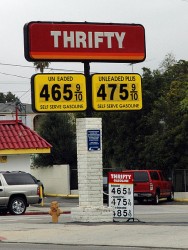 The Federal Reserve says that everything is going to be okay. The Fed says that unemployment is going to go down, inflation is going to remain low and economic growth is going to steadily increase. Do you believe them this time? As you will see later in this article, Federal Reserve Chairman Ben Bernanke has been dead wrong about the economy over and over again. But the mainstream media and many Americans still seem to have a lot of faith in the Federal Reserve. It doesn’t seem to matter that Bernanke and other Fed officials have been telling the American people lies for years. As I always say, most people believe what they want to believe, and many people seem to want to have blind faith in the Federal Reserve even when logic and reason would dictate otherwise. The truth is that things are not going to be getting much better than they are right now. When the next wave of the financial crisis hits, the U.S. economy is going to fall back into recession, financial markets are going to crash and unemployment is going to absolutely skyrocket. But you will never hear any of that from the Federal Reserve.
The Federal Reserve says that everything is going to be okay. The Fed says that unemployment is going to go down, inflation is going to remain low and economic growth is going to steadily increase. Do you believe them this time? As you will see later in this article, Federal Reserve Chairman Ben Bernanke has been dead wrong about the economy over and over again. But the mainstream media and many Americans still seem to have a lot of faith in the Federal Reserve. It doesn’t seem to matter that Bernanke and other Fed officials have been telling the American people lies for years. As I always say, most people believe what they want to believe, and many people seem to want to have blind faith in the Federal Reserve even when logic and reason would dictate otherwise. The truth is that things are not going to be getting much better than they are right now. When the next wave of the financial crisis hits, the U.S. economy is going to fall back into recession, financial markets are going to crash and unemployment is going to absolutely skyrocket. But you will never hear any of that from the Federal Reserve.
The following are 5 new lies that the Federal Reserve is telling the American people. After each lie I have posted what The Economic Collapse Blog thinks is actually going to happen….
#1 The Federal Reserve says that the labor market has improved and that unemployment is going to decline significantly over the next few years.
The following is a quote from the FOMC press release that was released on Wednesday….
Labor market conditions have improved in recent months; the unemployment rate has declined but remains elevated.
The Federal Reserve is projecting that the unemployment rate will fall within the range of 7.8 percent and 8.0 percent by the end of 2012.
The Federal Reserve is also projecting that the unemployment rate will fall within the range of 6.7 percent and 7.4 percent by the end of 2014.
The Economic Collapse Blog says that the labor market has not improved. In March 2010, 58.5 percent of all working age Americans had a job. Exactly two years later in March 2012, 58.5 percent of all working age Americans had a job. If the labor market was improving, the percentage of working age Americans with a job should have gone up.
The Economic Collapse Blog also says that while there is a chance the official unemployment rate may go down slightly in the short-term, the truth is that it is going to go up into double digits once the next wave of the financial crisis hits us.
#2 The Federal Reserve says that that U.S. economy is going to experience solid GDP growth over the next couple of years.
In fact, the Federal Reserve is projecting that U.S. GDP will be rising at an annual rate that falls between 3.1 percent and 3.6 percent by the end of 2014.
The Economic Collapse Blog says that a great economic cataclysm is coming….
“When the European banking system crashes (and it will) it is going to reverberate around the globe. The epicenter of the next great financial crisis is going to be in Europe, and it is getting closer with each passing day.”
#3 The Federal Reserve says that we can expect low inflation for an extended period of time.
The Federal Reserve is officially projecting that the annual rate of inflation will not be higher than 2.0 percent by the end of 2012. Federal Reserve Chairman Ben Bernanke reinforced this projection during his press conference on Wednesday….
“But we expect that to pass through the system, and assuming no new shocks in the oil sector, inflation ought to moderate to about 2 percent later this year.”
The Economic Collapse Blog says that the Fed is being tremendously dishonest and that if inflation was measured the exact same way that it was measured back in 1980, the annual rate of inflation would be more than 10 percent right now.
The truth is that most middle class families know that we do not have low inflation right now. This is hammered home millions of times a day when average Americans visit the gas station or the grocery store.
At the beginning of the next recession inflation will likely subside, but that will only be because economic activity will be slowing down dramatically.
#4 The Federal Reserve says that it has built up a 30 year reputation for keeping inflation low.
Ben Bernanke actually had the gall to make the following claim during his press conference on Wednesday….
“We, the Federal Reserve, have spent 30 years building up credibility for low and stable inflation, which has proved extremely valuable in that we’ve been able to take strong accommodative actions in the last four, five years to support the economy.”
Oh really?
The Economic Collapse Blog says that the Federal Reserve has nearly a 100 year reputation for destroying the value of the U.S. dollar. Even using the Fed’s doctored numbers, the value of the U.S. dollar has declined by more than 95 percent since 1913.
To get a really good idea of just how much the dollar has been destroyed by the Fed over the years, just check out this chart.
#5 Federal Reserve Chairman Ben Bernanke says that we should trust him because the Federal Reserve stands ready to do whatever is necessary to support the U.S. economy.
“If appropriate… we remain entirely prepared to take additional action”
The Economic Collapse Blog says that Federal Reserve Chairman Ben Bernanke is doing a great disservice by not warning the American people about the tremendous crisis that is coming. In a recent article I stated that this next crisis will blindside most Americans just like the last one did….
“Sadly, just like back in 2008, most people will never even see this next crisis coming.”
So who should you trust – the Federal Reserve or all of the half-crazed bloggers out there that are warning about the “serious doom” that is coming.
Well, come back to this article in a year or two and compare how accurate the predictions were.
In the end, time will tell who is telling lies and who is not.
If we do not learn from history, we are doomed to repeat it.
For example, let’s take a quick look at Ben Bernanke’s track record over the past several years.
The following are statements that Bernanke actually made to the public….
#1 (July, 2005) “We’ve never had a decline in house prices on a nationwide basis. So, what I think what is more likely is that house prices will slow, maybe stabilize, might slow consumption spending a bit. I don’t think it’s gonna drive the economy too far from its full employment path, though.”
#2 (October 20, 2005) “House prices have risen by nearly 25 percent over the past two years. Although speculative activity has increased in some areas, at a national level these price increases largely reflect strong economic fundamentals.”
#3 (November 15, 2005) “With respect to their safety, derivatives, for the most part, are traded among very sophisticated financial institutions and individuals who have considerable incentive to understand them and to use them properly.”
#4 (February 15, 2006) “Housing markets are cooling a bit. Our expectation is that the decline in activity or the slowing in activity will be moderate, that house prices will probably continue to rise.”
#5 (February 15, 2007) “Despite the ongoing adjustments in the housing sector, overall economic prospects for households remain good. Household finances appear generally solid, and delinquency rates on most types of consumer loans and residential mortgages remain low.”
#6 (March 28, 2007) “At this juncture, however, the impact on the broader economy and financial markets of the problems in the subprime market seems likely to be contained. In particular, mortgages to prime borrowers and fixed-rate mortgages to all classes of borrowers continue to perform well, with low rates of delinquency.”
#7 (May 17, 2007) “All that said, given the fundamental factors in place that should support the demand for housing, we believe the effect of the troubles in the subprime sector on the broader housing market will likely be limited, and we do not expect significant spillovers from the subprime market to the rest of the economy or to the financial system. The vast majority of mortgages, including even subprime mortgages, continue to perform well. Past gains in house prices have left most homeowners with significant amounts of home equity, and growth in jobs and incomes should help keep the financial obligations of most households manageable.”
#8 (January 10, 2008) “The Federal Reserve is not currently forecasting a recession.”
#9 (June 10, 2008) “The risk that the economy has entered a substantial downturn appears to have diminished over the past month or so.”
But don’t worry, Ben Bernanke insists that he knows exactly what is going on this time.
So do you believe him?
A lot of Americans don’t. In fact, an “economic collapse” is the number one catastrophic event that Americans worry about according to one recent survey.
Perhaps that is one reason why so many Americans are preparing for doomsday these days.
The central planners over at the Federal Reserve are not going to solve our economic problems.
The truth is that the Fed is at the very heart of our economic problems.
We have been living in the greatest debt bubble in the history of the world and that debt bubble has been facilitated by the Fed.
Over the past three decades, the total amount of debt in America has increased by about 50 trillion dollars. By stealing from future generations, we have been able to live like kings and queens, but there is going to be a great price to pay for our foolishness.
Ben Bernanke and the other folks running the Federal Reserve are just going to keep insisting that everything is going to be okay for as long as they possibly can. They are going to tell you that they know exactly how to fix things and that the economy will be back on track very soon.
Don’t be stupid and believe them this time.









